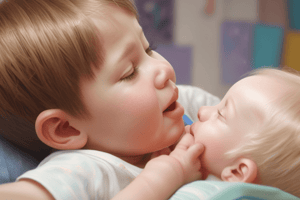Podcast
Questions and Answers
What is a primary emotion that infants commonly exhibit within the first six months?
What is a primary emotion that infants commonly exhibit within the first six months?
- Love
- Anger (correct)
- Happiness
- Jealousy
Which temperament trait is related to regulating attention and self-soothing?
Which temperament trait is related to regulating attention and self-soothing?
- Negative mood
- Social awareness
- Exuberance
- Effortful control (correct)
At what age does separation anxiety typically begin to intensify?
At what age does separation anxiety typically begin to intensify?
- 1 year (correct)
- 6 months
- 2 years
- 3 years
What factor influences social fear development in infants?
What factor influences social fear development in infants?
Which aspect of social involvement is indicated by positive early parent-infant interactions?
Which aspect of social involvement is indicated by positive early parent-infant interactions?
Flashcards are hidden until you start studying
Study Notes
Development of Emotions in Infants
- Infants progress from simple reactive experiences of pain and pleasure to complex socio-emotional awareness by 2 years.
- Primary emotions, such as colic, manifest as uncontrollable crying, typically subsiding by 3 months.
- Social smiles, evoked by human faces, begin to appear and are influenced by the infant's age since conception.
- Anger usually emerges around 6 months, while sadness can indicate withdrawal rather than a call for help in early months.
Factors Affecting Fear
- Fear is influenced by awareness of discrepancies in expectation, individual temperament, and social context.
- Social fear peaks during the middle of the first year and later diminishes.
Specific Phobias and Anxiety
- Separation anxiety starts at age 1, intensifies by age 2, and eventually subsides.
- Stranger wariness develops as fear of unfamiliar people. If persistent beyond age 3, it can lead to disorders like generalized anxiety or social phobia.
- One-year-olds become wary of unexpected events but can overcome fear with repeated experiences and reassurance.
Emergence of Self-Awareness and Secondary Emotions
- Self-awareness develops between 15 to 24 months, marking the realization that one's body, mind, and activities differ from others.
- Secondary emotions require an awareness of others’ feelings and actions.
Understanding Temperament
- Temperament reflects variations in emotions, activity levels, and self-regulation, rooted in genetic and prenatal factors.
- It affects an individual’s typical responses to their environment, influencing personality development.
Temperament Traits
- Effortful control: Ability to regulate attention and emotions, including self-soothing.
- Negative mood: Characterized by fearfulness and unhappiness.
- Exuberance: Associated with being active and socially engaging.
Impact of Stress on Development
- High levels of stress and fear can slow brain growth and reduce dendrite development.
- Chronic stress also impairs the immune system.
Importance of Caregiver Interactions
- Caregiver behavior during infancy significantly influences emotional responses in adulthood.
- Synchrony: Early parent-infant interactions aid the development of social skills; lack of synchrony can negatively impact emotional and brain development.
- The still-face technique highlights that synchrony is fundamental to expected developmental experiences.
Studying That Suits You
Use AI to generate personalized quizzes and flashcards to suit your learning preferences.




